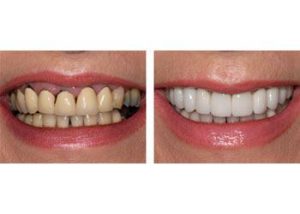1. Inlays and Onlays
by Admin
Posted on 10-09-2022 02:07 am
Inlays and onlays or indirect fillings are also an example of a cosmetic dentistry procedure.
 They are typically made from porcelain, gold, or composite materials and are used to fill damaged or decayed teeth. The two fillings differ on how it is applied in the tooth. A filling is called an “inlay” when the material is bonded within the center of a tooth, while it is called an “onlay” when the filling covers the biting surface and includes one or more tooth points. Inlays and onlays are a good alternative to crowns as they preserve a healthy tooth as possible.
They are typically made from porcelain, gold, or composite materials and are used to fill damaged or decayed teeth. The two fillings differ on how it is applied in the tooth. A filling is called an “inlay” when the material is bonded within the center of a tooth, while it is called an “onlay” when the filling covers the biting surface and includes one or more tooth points. Inlays and onlays are a good alternative to crowns as they preserve a healthy tooth as possible.
Also known as indirect fillings, inlays and onlays are created in a lab and used when teeth are decayed. We may recommend this solution if you don't have enough structure left to support a traditional filling. Inlays can sometimes be placed directly onto the tooth's surface if the tooth's cusps are undamaged. However, if the cusps are damaged, an onlay can be used to cover the tooth's entire surface. Inlays and onlays are made of composite resin. Adhesive dental cement is used to attach the inlay or onlay onto the tooth. They can provide support, prevent further decay and help restore the tooth's shape.
Dental systems and equipment accounted for the largest revenue share of over 30. 0% in 2021. This is attributed to their wide range of applications in the dental industry. Based on the product, the industry is segmented into dental systems and equipment, dental implants, dental crowns and bridges , dental veneers , orthodontic braces, bonding agents, inlays and onlays, and whitening. Dental systems and equipment include a variety of arrangements like instrument delivery systems, dental chairs , dental handpieces, light-curing equipment, dental scaling units, dental cad/cam systems, dental lasers, and dental radiology equipment. With the increase in the population wanting to improve dental aesthetics, the use of orthodontic braces comprising fixed and removable braces has increased rapidly.
Want to Improve Your Smile?
Teeth whitening
teeth whitening can be one of the simplest and least expensive ways to improve your smile. Teeth can be bleached with in-office products in your dentist’s office for about $500, or you can buy a mold and gels from your dentist to bleach your teeth at home. There are also whitening products available over the counter at retail stores for convenient at-home whitening : whitening toothpastes, rinses, and whitestrips. These products together run about $3 - $50.
Dental veneers are wafer-thin, custom-made shells of tooth-colored porcelain or resin that cover the front surface of the teeth. After removing about a half-millimeter of enamel from the tooth surface, these thin shells are bonded (cemented) to the front of the teeth, changing their color, shape, size, or length.
A veneer is a thin, custom-made porcelain moulding that’s bonded to the front surface of a tooth. Veneers are a quick and effective solution to misaligned, stained, misshapen or chipped teeth, as well as a cover-up for gaps when orthodontics isn’t suitable. Veneers offer a natural look, as they mimic the shape, size and colour of your original teeth. A single veneer can cover one discoloured tooth, or several can be put in place to improve your entire smile. Learn more.
Typically, cosmetic dentistry involves: the addition of a dental material to teeth or gums – bonding, porcelain veneers (laminates), crowns (caps), gum grafts. The removal of tooth structure or gums – enameloplasty, gingivectomy. Neither adding or removing dental materials, tooth structure or gums – teeth whitening (bleaching), laser whitening, gum depigmentation. Straightening of teeth accompanied by improvement in appearance of face – orthodontics. Cosmetic dentistry usually follows along the lines of symmetry and harmony. Certainly brightening teeth is something most people desire, removing stains (coffee, cigarettes). Everyone would like to be proud of their smile and show it off, but most do not because of gaps in their teeth, yellow teeth, uneven gums, missing teeth, etc.